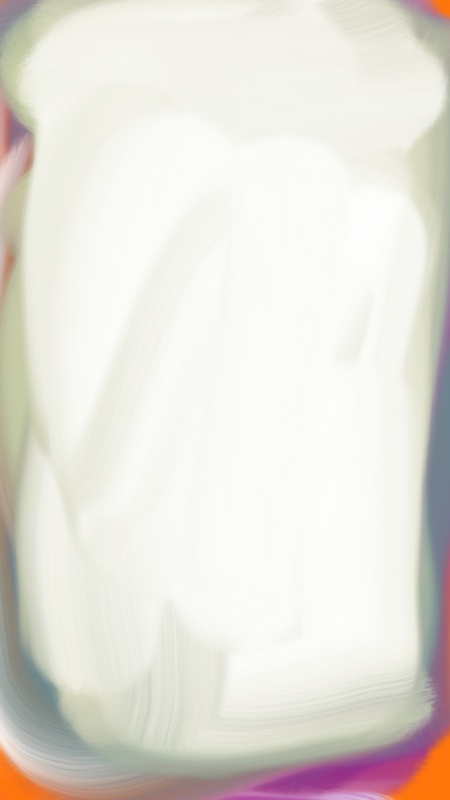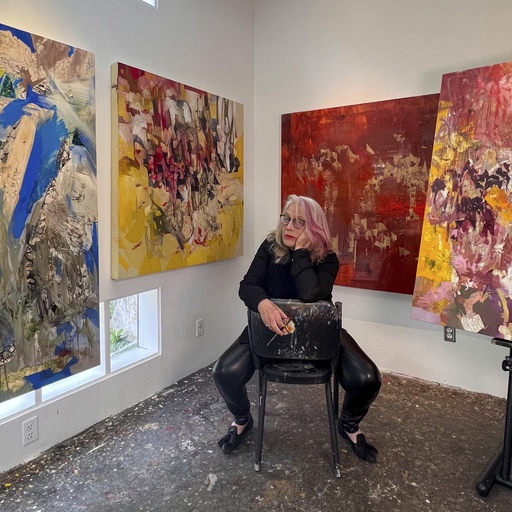Like many interesting artists, Félix Lazo's creative journey was, by his own admission, a pretty circular one. The Chilean artist started to paint and study art when he was 19-years-old but was subsequantly blindsided into an early life of music and biological science.
"After three years I quit biology and concentrated on my music studies, studying and working as a musician playing in Baroque music ensembles," he tells Artspace. "But I felt something was missing; then, one summer, I started to paint, and it was a revelation."
Lazo took up space in the studio of one of his friends, began studying cubism, and the work of Miro, and Matisse, and started to develop his own more experimental style of work which took him to New York Columbia University, Teachers College with a Fulbright Grant for two years. That 'circular journey' was still not quite heading in any discernible direction, however.
"I met a computer company CEO who asked me for a commission and provided me with the latest computer tech of that time. I developed animations, video art and interactive installations and moved to Paris to study computer music and electroacoustics. I designed a series of interactive programs with which I could interact in real time, creating shapes, color and sometimes sounds. But the more I controlled the machine, the more the results resembled my previous paintings. In 2019 I exhibited a mixed exhibition with computer-generated and handmade paintings.
Since then, Lazo has exhibited his paintings in venues around the world, including the Museum of Contemporary Art, Santiago, Chile, Marlborough Gallery, Santiago, Chile, Goethe Institut, Santiago, Chile, AC Institute, New York, La Guardia Performance Center, Queens, New York, and Joyce Yahouda Gallery, Montreal, Canada.
In this interview, published to announce the artist's inclusion in Artspace's Artist Direct program, which offers straightforward access to under-discovered and rising art stars' work; he describes how the silence and the skies around his house in Frutillar, Chile, on the edge of Patagonia, inspire him, and how he aims to create paintings that appear to vibrate in front of those who encounter them.
FELIX LAZO - Ph_series_11, 2022
How would you describe your work to someone who has never seen it? I live in Frutillar, Chile at the edge of Patagonia, by the Llanquihue Lake, the landscape down here is amazing, and nature is very alive. I have discovered unconscious influences of the landscape in my work.
One of the main characteristics of my work is color vibration. The composition of the work is set in a way that makes the work vibrate. For some people it has a sonic feeling. I had a friend who would start humming every time he came into my studio and looked at the paintings.
FELIX LAZO - Ph_series_07, 2022

These concepts make sense for me since my first language is music. I started my music studies at the age of 13 and by 19 I was a recorder virtuoso. Then I turned towards painting, but I still play the flute.
My work is abstract, and it is rooted in the colorfield tradition; post-minimalist and close to a lyrical abstraction that relates somehow to music.
I do not create images but visual trajectories with the aim of inviting the viewer into a succession of visual events that can interact with the body and mind.
FELIX LAZO -
Ph_series_01,
2022

What made you want to become an artist?
I come from a family of writers and my mother was very interested in art, so there were a lot of art books in my house. It was a very unconscious journey from being a musician and then an artist. It’s about the search for something special, deep and meaningful.
What was your earliest art creation?
My first paintings were done at 14, I showed them to a friend a little older than me, he was coming back from his studies at the Academia of San Fernando in Madrid where Picasso and Dali studied. He was very gifted and came from a family of painters. He saw my paintings, and since I was already an advanced flute player, he advised me to pursue music and forget about painting. Five years later, when I was finishing my music studies, I started painting again.
How has your work changed over the course of your career? My work has been very experimental; I am always challenging myself with new processes and different mediums. I started painting figures and still lifes, very academic, then big canvases of life-size figures in intense colors; then abstraction and objects, computers and video, interactive installations and creating digital paintings with code and interaction; now I am painting again.
FELIX LAZO - Rescue_Edition (alfa)_01 , 2021

What should people look for in your work and what do you hope they might get out of your art?
First, I would like them to feel absorbed and immersed in a vibrational experience that can remove them from the everyday thought process to a different dimension and give them something refreshing and inspiring.
What are the current things going on that inspire you?
The silence and the landscape around my house, the skies and the lake. I am always reading scientific papers and thinking of new concepts and theories of structures and systems of life organization.
I studied Biological Sciences at the Faculty of the University of Chile for three years after finishing high school, and somehow these studies have been part of my creative process, giving me conceptual tools to allow me to experiment with different approaches to my work.
I love paintings from different periods, and I am always visiting museums and reading about painting. I love Cezanne watercolors, Van Gogh pen drawings, Durer, El Bosco, Agnes Martin, Morandi and contemporary artists too.
FELIX LAZO -
Robots Dreams Tryptic_ Beta
, 2022

Where do you fit in, who do you think you belong alongside?
Contemporary Abstract painting. I see that most of the contemporary abstract painters are dealing with more or less the same problems, such as: extreme composition, questioning the narrative, the painting as object and texture, gesture, colorfield and the whole history of abstract painting!
What do you think about when you’re creating?
When I am creating, I usually do not think. I am conscious that I am making decisions based on concrete facts such as intensity of color, tuning, atmosphere, nuances, composition and textures. My main concern is to make the painting vibrate.
FELIX LAZO - SistemaAutopoiético_818_6 , 2018

Where do your titles come from?
Since my works deal mainly with vibrating sensations, I used to name them with phonetic invented words something like “uuuhaniiii” trying to relate what I was seeing in the work with the sound I imagined.
Some time ago I was exhibiting at the Contemporary art Museum in Santiago, Chile in a group show. The work I was showing was a series of small paintings with sticks and treads on the walls. There were 13 of these and they all had a small card underneath with a phonetic name on them.
One day after the opening I revisited the show and a woman with her daughter, around 10-years-old, entered the room and started to look at the work. The mother commented “I do not understand this work” and the daughter looked at her and started to sing the phonetics on the cards. I was delighted!
In my digital work I mostly work on series derived from the programs I design, and the names of the series are related to the processes involved. In one of the series, I was working with an algorithm that could detect and follow the contour of the shapes, so I named the series
Contour Follower
.
FELIX LAZO - Ph_series_13 , 2022
Can you control where the process takes you?
I prefer the surprise of where the process is leading me. Sometimes I have a lot of works in progress, and they start to crystallize at different times. This approach produces a kind of vertigo and frustration because you are working, most of the time, in the dark with no map; but the reward of finding something unexpected is amazing.
Could you describe a typical working day? It depends a lot on the projects I am working on, nowadays I am back to painting. I get up at 6:50am, prepare breakfast and take my daughter to school, a 15-minute ride through the fields. When I’m back, I have a strong coffee and set up for work, drawing, weaving or painting or office work. I like to paint in the afternoon because my mind continues to paint when I am sleeping and sometimes, I wake up with ideas and solutions for the works.
FELIX LAZO - Rescue_Edition (alfa)_05

Tell us a little about some of your works on Artspace
Rescue_Edition (alfa)_05 is part of a series of digital paintings that relate to the mist. Sometimes where I live there is a heavy mist in the mornings and as the day unfolds, different colors begin to appear. The space that this creates is extremely interesting for me, creating a sense of borderlessness and also a space that is somehow condensed.
FELIX LAZO -
seguimiento de Contornos_Prints_07
2018

seguimiento de Contornos_Prints_07 is born from an interaction with visual algorithms that follow the contours of the movement and generate an oval of color in the negative spaces. The interesting thing for me is how the movement appears with different times and how the work radiates a 'strangeness'.
FELIX LAZO - Rescue_Edition (alfa)_03

Rescue_Edition (alfa)_03
In this work there is a very slow movement, and a space appears where some shapes are closer to the viewer than others that seem to recede in space. It is apparently simple, but after a while it absorbs the gaze.
What are you working on at the moment?
A self-commissioned project, an oil painting over hand woven canvas, some made of cotton others of linen. It started in January of this year (2023). Last year, I had four solo shows in different cities, and I needed to stop for a while. I exchanged a drawing for a loom, assembled it and started weaving. Then I remembered the painting
Las Meninas
I had seen in
El Prado
some years ago, and one of the things I remembered was how the thick three panels of canvas were sewn together.
So, I started this series of paintings, weaving the canvas and painting over it, generating a tension between the paint and the texture of the canvas. It is just beginning, and I am pretty enthusiastic about this project.
Take a look at more work by Félix Lazo on his Artspace page here .





























